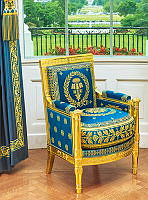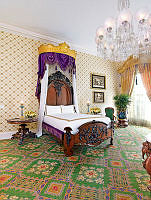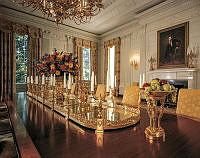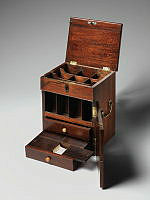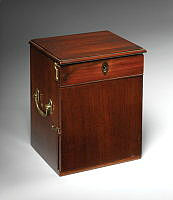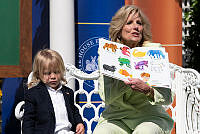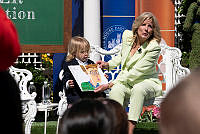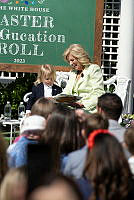Rubenstein Center Scholarship
Diversity in White House Art: Henry Ossawa Tanner
Henry Ossawa Tanner was one of the most distinguished Black artists of the nineteenth and twentieth centuries. Despite his immense success, Tanner’s life story reveals the challenges faced by many Black artists. He was born in Pittsburgh, Pennsylvania, on June 21, 1859. His mother, Sarah Tanner, was a formerly enslaved woman who escaped to freedom on the Underground Railroad, while his father, Reverend Benjamin Tanner, was a bishop of the African Methodist Episcopal Church.
Benjamin and Sarah gave their son the middle name “Ossawa” in honor of the abolitionist John Brown.1 Brown brought the fight for abolition to Osawatomie, Kansas in 1855, in the wake of the 1854 Kansas-Nebraska Act. Confrontations between anti-slavery proponents and pro-slavery supporters led to widespread violence and later all-out guerilla warfare, aptly nicknamed “Bleeding Kansas.” The name “Ossawa” celebrated Brown’s struggles to fight against pro-slavery forces in Osawatomie.2 In 1868, the Tanner family moved to Philadelphia. Tanner enrolled in the Pennsylvania Academy of the Fine Arts in 1880 and studied under painter Thomas Eakins. He achieved modest success as an artist in Philadelphia and then established a photography studio in Atlanta, Georgia, in 1889.3

This painting of a windy beach with rising, sandy dunes is by African-American landscape painter Henry Ossawa Tanner. It is the first painting by an African-American artist acquired for the White House Collection. The painting looks out from the beach towards the ocean, though only small waves cresting on the horizon and two far off sailboats are visible. The dunes and shore take up the majority of the canvas and Tanner actually mixed sand into his pigments to better capture the rough texture.
White House Collection/White House Historical AssociationHowever, throughout his early career in the United States, Tanner also struggled with discrimination and racial prejudice. In 1891, Tanner left the United States for Paris, France. He stated, “[Racism] has driven me out of the country and while I cannot sing our National Hymn… still deep down in my heart I love it and am sometimes sad that I cannot live where my heart is.”4 In Paris, he began studying with Jean-Joseph Benjamin Constant and Jean-Paul Laurens at the Académie Julian. He experienced a much more liberal and inclusive atmosphere in France than he had in the United States.5
During a brief return to America, Tanner painted and exhibited one of his best-known works, The Banjo Lesson, at the 1893 World’s Columbian Exposition in Chicago, Illinois. This piece features an elderly Black man instructing a young boy how to play the banjo. The painting is notable for its departure from the typical caricatures of African Americans of the time period. The painting demonstrates a “tenderness” between the old man and the young boy.6 His success capturing Black subjects took him back to Paris where he exhibited this piece in the Parisian Salon in 1894.7

This circa 1999 color photograph depicts the Green Room of the White House during the administration of President Bill Clinton. The room features many Federal style pieces of furniture. Artwork in this image includes a circa 1810 bust of Benjamin Franklin by the National Porcelain Manufactory of Sevres, France, Ferdinand Richardt's circa 1858 Independence Hall in Philadelphia, and Henry Ossawa Tanner's circa 1885 Sand Dunes at Sunset, Atlantic City.
White House Historical AssociationShortly thereafter, Tanner began painting the biblical scenes that made him famous, including Daniel in the Lions’ Den (1895) and Resurrection of Lazarus (1896). These pieces were honored in the Salon de la Société des artistes français and museums began to acquire his paintings, earning him international acclaim. In 1899, he married a white woman named Jessie Macauley Olssen—which further enflamed racial attitudes toward Tanner. That same year, Booker T. Washington visited him in Paris and Tanner painted Washington’s portrait.8
Tanner continued to receive attention for his artwork during the early twentieth century. In 1909, he became an associate member of the National Academy of Design, and a full member in 1927. During World War I, Tanner worked for the American Red Cross and continued to create paintings and drawings depicting the front lines of trench warfare. In these works, he sometimes depicted African-American troops, a rarity in World War I era artwork. He continued to paint during his later years and died in Paris on May 25, 1937.9

This 1893 painting by Henry Ossawa Tanner, depicts an elderly man giving lessons to a young boy. One of Tanner's best known works, this painting was displayed at the 1893 World's Columbia Exposition in Chicago, Illinois.
Library of CongressIn the Spring of 1994, First Lady Hillary Rodham Clinton began collaborating with art experts to identify a piece of art by an African-American artist that would be compatible with the White House Collection.10 In 1995, the White House Historical Association acquired a Tanner painting titled Sand Dunes at Sunset, Atlantic City from his grandniece Rae Alexander-Minter. It was the first painting by a Black artist acquired for the White House Collection. Tanner painted this piece sometime around 1885, likely to mark the culmination of his studies with Thomas Eakins at the Pennsylvania Academy of Fine Arts. The painting features a windblown beach surrounded by rising dunes. To emulate the texture of the beach, Tanner mixed sand into his pigments. In the foreground, wind-bent clumps of dune grasses bow to the elements. The ocean is depicted as a silver sliver just below the wide evening sky while the moon rises in the background and sailboats dot the horizon line.

Artist Henry Ossawa Tanner achieved recognition at the Salon de la Société des artistes français for a painting titled Daniel in the Lions’ Den. During the 1890s, Tanner began painting biblical scenes like this one, earning him great fame and success. While the original painting submitted was lost, this image is a similar version painted later.
Los Angeles County Museum of ArtThe painting was unveiled by President and Mrs. Clinton during an East Room ceremony on October 29, 1996. The President delivered remarks honoring Tanner:
And this magnificent artist whom we honor tonight had to live in the afterwash of the Civil War and our continuing struggle to come to grips with our obligations as a people, both moral and constitutional. Now, a long time after that and too long in coming, this great painting will hang in the Green Room and over 1 1/2 million visitors will see it every year. Most of them, but not all of them, will be Americans. Of the Americans, they will come from more than African-American and Caucasian-American stock. They will now come from a myriad of racial and ethnic and religious groups. But when they stop in the Green Room and look at this beautiful work of art, they will know that America here in the people's house is moving again toward its ultimate destiny and living closer to its ideals.
Today, Sand Dunes at Sunset, Atlantic City hangs in the Green Room on the State Floor of the White House.
















